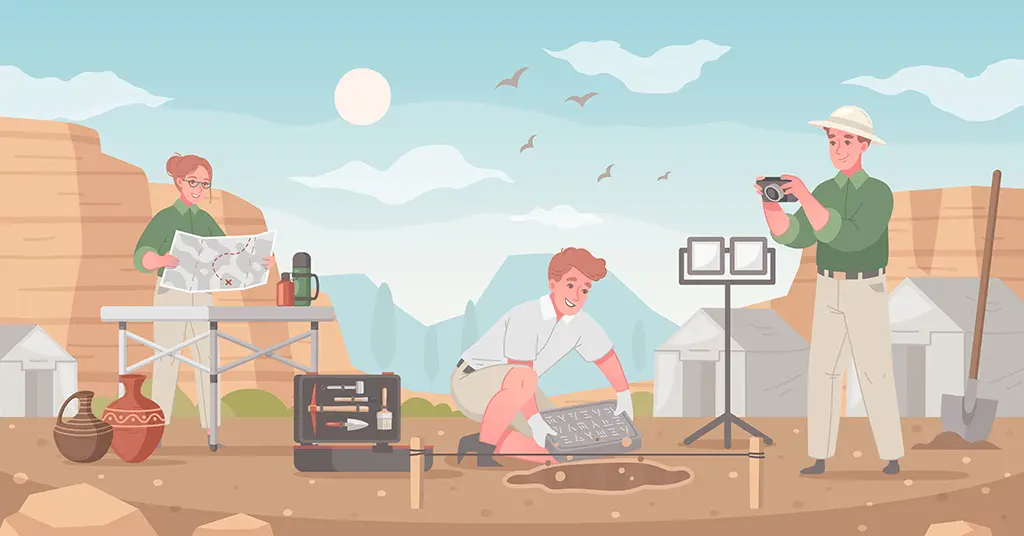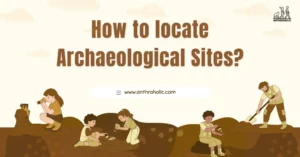AI Answer Evaluation Platform Live Now. Try Free Answer Evaluation Now
Archaeological Ethics
The ethical questions brought up by studying the physical past are called “archaeological ethics.” It is a subset of archaeology’s philosophy. The preservation of human remains, laws preserving human remains and cultural artifacts, worldwide issues, and preservation and ethnoarchaeology will all be explored in this article.

Archaeologists must carry out their study to a high standard and conform to all existing regulations, especially those controlling intellectual property, public health, and safety. Field archaeologists must support outreach activities, aim toward the preservation and management of archaeological resources, and handle human remains with care. Professionals who break these ethical norms are liable to punishment. In Western Europe and North America, the 1960s and 1970s witnessed the growth of ethical challenges associated with archaeology.
One of the earliest steps toward putting ethical ideals into effect was the UNESCO ratification in 1970 to conserve world culture. Archaeologists must adhere to the Nuremberg Code (1947) and the Declaration of Helsinki Principles of Archaeological Ethics when doing ethnoarchaeological research, which requires observing actual people
History of Archaeological Ethics
The early archaeologists were generally amateurs who investigated a site only to amass as many objects as possible to put on exhibit in museums. What many professional archaeologists now consider unethical archaeological techniques was justified by an interest in ancient people and the possibility of unearthing valuable and intriguing relics. Many early archaeologists began documenting their finds as knowledge turned toward science. The Antiquities Act, the first statute in America to help control archaeological findings, was adopted in 1906.
This statute protected the government against the looting of sites but did not insulate local people from having their land and ancestors’ things removed. In 1934, the Society for American Archaeology was founded. This group gave professional archaeologists uniform training and contributed to establishing regulations for the subject. The field of cultural resource management, which shelters archaeological sites from encroaching development, was formed by various laws passed in the 1960s and 1970s. Throughout the 1980s, issues surrounding native peoples’ rights to their ancestors’ belongings reached a climax with the enactment of the Native American Graves Protection and Repatriation Act. The emergence of ethics in archaeology was prompted by the post-processualism shift in archaeological theory, which focuses on methodological critique and the political ramifications of archaeology.
Considering the Living While Honoring the Dead
Making archaeological research findings available to the public is only one aspect of serving the public interest. In addition, it requires conveying information and sharing expertise in the formulation of legislation and policy as well as paying particular attention to the fears and sensibilities of individuals whose contemporary lives are influenced by the retrieval of historical data[1].This principle is demonstrated by the ethical problems with the management of human remains. If concerns about priority access to human remains left historical archaeologists largely unscathed
Archaeological Ethics in Study and Practice
Historical archaeology experienced several decades of identity crisis as it evolved and advanced, which had an influence on how archaeologists defined their study activities. The primary concerns under contention were whether the subject was a subdivision of history, anthropology, or possibly something different (for a relevant modern discussion). For many, bringing historical archaeology into anthropology meant disregarding history and addressing historical sites using approaches established in prehistoric archaeology. For those who viewed the topic as essentially historical in nature, analytical tools aimed at evaluating and interpreting archaeological sites as complex matrices were judged unimportant. In both cases—documents in the latter and excavation data in the former—one sort of evidence was given precedence over another.
However, there is growing consensus that historical archaeology is a fully interdisciplinary (or, perhaps more accurately, transdisciplinary) field that emphasizes context in all of its forms, including cultural, historical, environmental, and archaeological context.
This has repercussions for deciding what is proper behavior in the practice of historical archaeology as well as the sort of training someone needs to get in order to conduct historical archaeology in a professional, responsible, and acceptable manner. There are many instances of people with prehistoric training or inadequate training in historical archaeology starting projects without knowing the variety of sources available to them, how to use them, or even the most fundamental understanding of the historical context(s) of or literature pertinent to the sites under study. As a result, substandard work that frequently treats historical areas as if they were prehistoric is created, squandering both financial and cultural resources.
Jean Wilson’s study of William Shakespeare’s social, intellectual, and material world provides a poignant case study of how London archaeologists misinterpreted the remains of the Globe Theatre when they first discovered them due to a lack of a solid foundation in the pertinent literature; in this instance, historians and archaeologists were largely unaware of each other’s knowledge and concerns. According to Wilson , “the problem is not as simple as a lack of cooperation”;[2] rather, because one side was uninformed of the other’s discipline, neither side was able to profit as thoroughly from the work at the Globe and the Rose as they should have.
It is clear that historical archaeologists require specialized training that goes far beyond methods and techniques of excavation, in addition to the obvious lesson for archaeologists that they need to step up their efforts to educate the general public and other academics about archaeological methods and interpretation.
It’s also likely that this is the sole ethical dilemma peculiar to historical archaeology, even though it’s evident that all professionals must finish the training required for their chosen speciality. The premise is that historical archaeology is a subject of study unto itself that requires specialist instruction. It is not something that can be learned in a “quick study” or by reviewing a few books on historical archaeology and artifacts from historical eras if one comes into a historical site during a resource evaluation.
If proper training is required for students to become competent historical archaeologists, professional historical archaeologists—especially those working in academia—need to create programmes that cover every aspect of what the industry considers to be mandatory credentials for historical archaeologists. This involves teaching in anthropological and archaeological theories and methodologies; history; historical research; historiography; identification, analysis, and interpretation of material culture; and museology, in addition to education in these subjects. It also involves training in workplace issues and management difficulties [3]
Principles Of Archaeological Ethics
- Stewardship: The archaeological record, which comprises in-situ artifacts and sites, collections, records, and reports, is precious. All archaeologists have a responsibility to practice and promote stewardship of the archaeological record in order to strive for the long-term conservation and preservation of the archaeological record. As they study and interpret the archaeological record, stewards should use the specific knowledge they gain to improve public awareness and support for its long-term preservation. Stewards are both carers for and champions for the archaeological record for the benefit of all people.
- Responsibility: In order to undertake ethical archaeological research—at all levels of professional activity—it is vital to understand the need for public accountability and to make every effort—in good faith—to actively engage with any impacted groups. This will assist in developing a working connection that will be favorable to all parties.
- Commercialization: The loss of the archaeological record on the continents of North and South America and elsewhere is something that the Society for American Archaeology has long highlighted as an issue. Archaeological sites and contextual data that are vital to interpreting the archaeological record are lost when archaeological items are commercialized or used as commodities to be exploited for personal pleasure or financial gain. Therefore, archaeologists should carefully balance a project’s academic rewards against the disadvantages of perhaps enhancing the financial value of archaeological objects. When practical, they should discourage and refrain from measures that boost the market value of artifacts, especially those that are not held in public collections or publicly available for scientific study, public interpretation, and display.
- Public Outreach and Education: To better the preservation, protection, and interpretation of the archaeological record, archaeologists should interact with other parties having an interest in the record. In particular, archaeologists need to take on the following tasks: 1) gain public support for the preservation of the archaeological record; 2) explain and advocate the use of archaeological methodologies and techniques in understanding human behavior and culture; and 3) disseminate archaeological interpretations of the past. There are numerous audiences for archaeology, including students and educators, Native Americans and other ethnic, religious, and cultural groups that find significant facets of their cultural heritage in the archaeological record, legislators and government officials, reporters, journalists, and other media professionals, as well as the general public. Archaeologists who are unable to actively participate in public education and outreach should aid and encourage colleagues who can.
- Intellectual property: The archaeological record contains intellectual property, as it is found in the knowledge and documentation created through the study of archaeological objects. As a consequence, it should be treated according to stewardship principles rather than as a concern for personal property. For a limited and acceptable amount of time, a researcher may have exclusive access to original materials and records provided there is a compelling purpose, no legal limitations, and no substantial competing interests. Thereafter, these resources and papers must be made available to others.
- Public reporting and publishing: The knowledge that archaeologists discover by researching the archaeological record must be made accessible to as many interested parties as possible within a reasonable length of time (either via publication or other techniques). The documents and resources that serve as the basis for publications and other public reporting should be preserved permanently in a safe place. When disseminating information about the nature and location of in situ archaeological sites, the preservation and protection of these sites must be considered.
- Record-keeping and preservation: The preservation and long-term accessibility of archaeological collections, records, and reports should be actively encouraged by archaeologists. As a means of preserving the in situ archaeological record and raising the level of care and attention given to that portion of the archaeological record that has been removed and incorporated into archaeological collections, records, and reports, they should encourage coworkers, students, and others to use collections, records, and reports responsibly in their research.
- Resources and Training: Given that most archaeological investigations are destructive, archaeologists must make sure they have the knowledge, skills, resources, and other resources necessary to carry out any programme of research they begin in a way that is consistent with the aforementioned principles and modern standards of professional practice.
Conclusion
This leads us to conclude that archaeologists must conform to certain local, state, and federal rules and demonstrate concern for individuals who might be tied to the culture they are investigating. Before visiting private land, archaeologists—both professional and amateur—should be cautious about gaining the approval of the owners and tenants. It is unlawful to gather artifacts on federal and state lands. To work in such areas, archaeologists must seek permission and establish that they have a sufficient purpose for doing so.
We determine the baseline for good conduct using archaeological ethics, a set of norms embodying the goals that the profession as a whole has in common. Fundamentally, ethical guidelines offer a way to control oneself, but on a more intricate level, archaeological ethics offer a way to control practise, negotiate politics, and define how we as archaeologists interact with others—the people we study, their descendants, and everyone who will be impacted by the results of our work. The essential location of ethics, according to Lynne Meskell, is at the crossroads of identity and politics. She adds that we must give up “the notion that the subjects of our study are dead and buried, literally, and that our “scientific” research interests are paramount.”[4] —archaeological ethics involve our professional behavior as well as how we deal with individuals who are not archaeologists. They are not simply about us as archaeologists. The ground for understanding professionally right behavior and the basis of one’s professional identity are ethical standards, which express the principles at the core of the sector.
See Also
References
[1] Leahy, K.A., and Paterson, C., 2001, New Light on the Viking Presence in Lincolnshire. In Vikings and the Danelaw: Select Papers from the Proceedings of the Thirteenth Viking Congress, edited by J. Graham-Campbell, R. Hall, J. Jesch, and D.N. Parsons, pp. 181–202. Oxbow, Oxford https://www.worldcat.org/title/-/oclc/1017945609
[2] Wilson, J., 1995, The Archaeology of Shakespeare: The Material Legacy of Shakespeare’s Theatre. Alan Sutton, London.
[3] Mrozowski, S.A., 2006, The Archaeology of Class in Urban America. Cambridge University Press, Cambridge
[4] Meskell, L., and Pels, P., 2005a, Introduction: Embedding Ethics. In Embedding Ethics, edited by L. Meskell and P. Pels, pp. 1–26. Berg, Oxford




